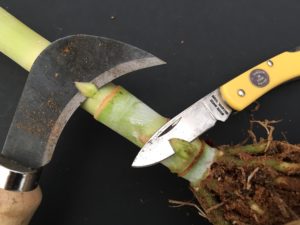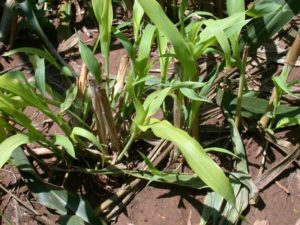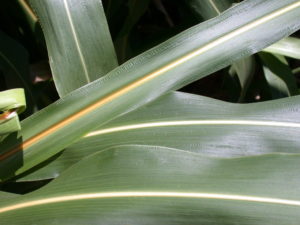Dr. Calvin Trostle, Extension Agronomy, TAMU Soil & Crop Sciences, Lubbock, TX
(806) 723-8432, ctrostle@ag.tamu.edu
February 10, 2020
I have written previously for Texas Row Crops Newsletter about hybrid pearl millet (HPM) in May 2015 and June 2017. The focus of then was the tolerance if not near absence of sugarcane aphid (SCA) activity in HPM. We continue to regard HPM as a poor host for SCA. Additional evidence in several Texas locations since 2017 reaffirms this.
For Texas forage growers, HPM remains a potential alternative to sorghum/sudan (haygrazer) forages, which are susceptible to SCA. Some Texas seed companies may now have a sorghum/sudan hybrid marketed with SCA tolerance. I have a grown a some of these in High Plains trials in 2018 & 2019. SCA levels were low, including a ‘check’ susceptible sorghum/sudan, relative to susceptible grain sorghum hybrids.
The bottom line is that producers concerned about SCA in sorghum forages may consider hybrid pearl millet, especially if you are not equipped to spray for SCA. This might more be the case for someone with small acreage or a livestock producer. I still recommend you scout the millet to ensure any SCA presence remains low. If there are no grain sorghum or sorghum/sudan fields nearby you look at Johnsongrass to see if you notice SCA activity there.
Key Comparisons & Contrasts of Sorghum/Sudan & Hybrid Pearl Millet
Sorghum/sudan is a highly versatile forage for Texas. It is relatively drought tolerant and grows well under a variety of field conditions. In contrast to forage sorghums, which are grown for large one-time harvests (usually silage), the retillering capacity of sorghum/sudan (and HPM) is good (Figures 1 & 2). This makes it an ideal fit for grazing or haying operations where regrowth is desired. Some Texas producers in Central and South Texas might be able to get even a third cut. (Be sure to consider N fertilizer after cuts 1 & 2.) This is especially true if you are cutting for higher quality forage harvested no later than boot stage.
Figure 1. Axillary buds, one per node, in sorghum/sudan can generate a new tiller hence forage regrowth after grazing or baling. Most tillers will emerge from the lowest nodes at the base of the stalk among the roots.
Figure 2. Retillering and regrowth in sorghum/sudan after swather hay harvest.
There are some different types of sorghum/sudans on the market:
- Traditional (or conventional) sorghum/sudan. These are straightforward crosses that have been common for decades.
- Brown midrib (BMR). These hybrids possess some visual traits (the midrib in the leaf is tan or brown, Fig. 3), but the distinctive feature is lower lignin content. Lignin is a structural component and helps the plant stand up. The lignin reduction could typically be 20% to 33% and possibly more. Most hybrids for BMR stand OK unless they become top heavy with a head of grain—which you should not allow for a forage because the quality is much lower. The %TDN (total digestible nutrients) in BMR hybrids is generally somewhat higher than conventional sorghum/sudans. Yields may be slightly lower, but in contrast the market value of BMR hybrids should be better per ton. In several instances Texas A&M AgriLife Extension has observed grazing preference for BMR hybrids when traditional hybrids were drilled in the same field.
- Photoperiod-sensitive These hybrids will not enter the reproductive phase until September regardless of planting date (e.g., April 1 vs. July 1). These hybrids tend to produce higher tonnage, but the forage quality is consistently lower.
Some growth attributes of hybrid pearl millet offer advantages over sorghums. These include:
- HPM has a different iron uptake mechanism in the root. It is more able to acquire iron in high pH soils or where you have chalky/whitish soils from caliche (geologic calcium carbonate). Sorghums of any kind often yellow up with classical iron deficiency symptoms to the point a farmer knows certain fields are not suitable for grain sorghum, sorghum/sudan, etc.
- Hybrid pearl millet is not a member of the sorghum family. It does not develop prussic acid the way sorghums can after a) new summer growth due to rain or irrigation after strong drought stress where little growth is occurring, b) foliage injury due to frost or a light freeze in the fall. Grazing livestock do not need to be removed from HPM when the first fall frost or freeze comes.
- HPM is a leafier forage than sorghum/sudan with a leaf:stem ration > 1.
- Some caveats of hybrid pearl millet are: 1) Seed is much smaller (70,000-90,000 per lb.) and so drills need to be shut down to not overplant; seed likely can’t be drilled as deep; 2) Forage yields tend to be lower than sorghum/sudan unless strong drought conditions prevail where millet may become more productive.
- HPM is also available as a BMR hybrid from a few companies.
Fig. 3. The visual difference of a brown midrib sorghum/sudan vs. conventional hybrids.
Sorghums & Millets and Forage Quality
Like any other forage, increasing maturity means more tonnage per acre but a reduction in forage quality. In general, the optimum balance between forage quality and tonnage for sorghums and millets is harvesting in mid- to late-boot stage. For some examples of forage quality changes with time see http://agrilife.org/lubbock/files/2011/10/hiplainsforagetypes_10.pdf Forages that head out and produce grain are not desirable. Any grain that is consumed by the animal may pass through the rumen undigested. Cattle may not want to eat the remaining forage, and fields can turn into a ‘bamboo forest’ (Fig. 4). In contrast, I have observed grazing cattle eat free-choice the stalks of brown mid-rib forages when some leafy material remained on leafy sorghum/sudans.
Forage Quality Testing
Too little Texas forage is bought and sold without anything more than ‘eyeball’ assessment of forage quality. The market value of forage should reflect forage quality. If you are buying forage you may ask if you can take a sample of the forage and have it analyzed for protein (at least), and also %TDN, lignin, acid and neutral detergent fibers (ADF, NDF), and relative feed value (RFV) or the more accurate relative feed quality
Figure 4. This sorghum/sudan field has little value. Cattle have stripped the leaves and the stalks remain. Most of the forage headed out which reduces forage quality. It is likely cattle should have been turned into graze several weeks sooner to prevent heading.
(RFQ). Several labs offer forage quality analysis, including Texas A&M AgriLife Extension’s Soil, Water & Forage Lab. See our Extension plant/forage sample submittal form at http://soiltesting.tamu.edu/files/Forageweb2.pdf Page 2 provides sampling instructions.
Should I consider a BMR forage?
If you are not familiar with how BMR forages may perform on your farm or ranch, I suggest you purchase a single bag of BMR forage from two or three different companies. This is especially true in a grazing situation. Though BMR forage seed costs more, modest seeding rates control that cost some. It is worth it to try a least a bag.
Planting vs. Drilling Summer Annual Forages in Hot, Dry Soils
Drills to not do as well as row crop planters when placing seed in optimum conditions for germination and establishment. In the dry regions of Texas during hot dry years I suggest growers consider using a planter, even if on 40” rows, rather than a drill. You need the forage. You may be able to get to moisture if you can move some soil with your planter’s trash whippers, shovels, etc. Drilling would be futile unless you get a rain. I have measured yields above 2 tons per acre on a dry weight basis in this scenario. You probably need to set your planter at about the highest seeding rate you can achieve using sorghum plates as if you were planting grain sorghum. This could be 120,000 seeds per acre, or about 5 to 6 lbs./A.
Further Summer Annual Forage Resources
For additional information about sorghum/sudan and hybrid pearl millet management consult:
Central and East Texas: “Warm-season annual forage grasses for Texas” (2012), E-630, Texas A&M AgriLife Extension Service (V.A. Corriher), http://foragefax.tamu.edu/files/2013/05/WSAForagesforTexas.pdf
West Texas:
“Millets for Forage and Grain in New Mexico and West Texas” (2012), A-417, New Mexico Cooperative Extension Service (M.A. Marsalis, L.M. Lauriault, C. Trostle), http://lubbock.tamu.edu/files/2012/07/Millets-for-NM-West-TX-2012-A-417.pdf
“Annual Summer Forages for West Texas” (2010), http://agrilife.org/lubbock/files/2011/10/hiplainsforagetypes_10.pdf
“Suggested Summer Forage Seeding Rate Targets for West Texas,”, http://agrilife.org/lubbock/files/2011/10/hiplainsforageseedrates_9.pdf




